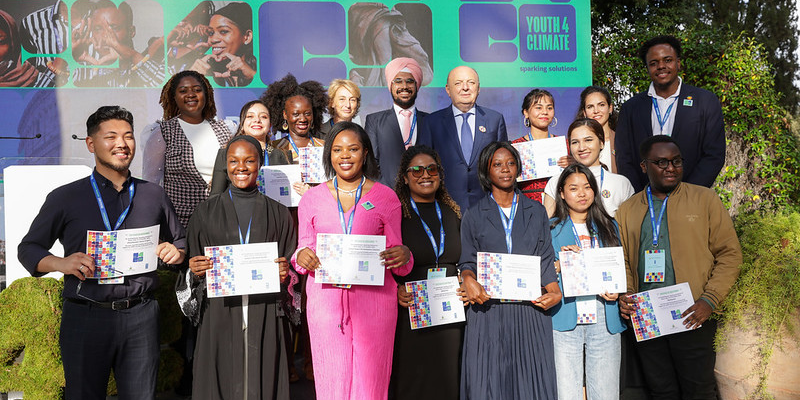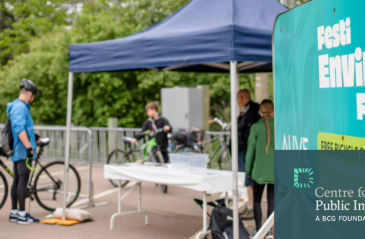
The information barriers holding back climate action and how to break them


How are governments across the globe centring young people and enhancing their potential to accelerate #climateaction? @CPI_foundation share 6 examples, from @Y4Cofficial to @MuniLima.
Share article"Governments owe it to young people, who hold the risk of current decisions yet have the least power, to take action and shape climate-related policies."
Share articleLet's inspire young people to focus on #climateaction! Explore 6 ways governments can help, from incorporating climate in school curriculums to engaging young people in decision-making processes.
Share articleWe put our vision for government into practice through learning partner projects that align with our values and help reimagine government so that it works for everyone.
Image source: European Institute of Innovation & Technology
Around the world, young people are demanding climate action to secure a just, sustainable future. With COP 28 recently concluding, there’s been a notable increase in youth participation, with initiatives like the Youth Climate Champion role and the International Youth Climate Delegate Programme.
Engaging youth in tackling climate change is crucial. They are not only the generations most affected by climate change's consequences but also the leaders of tomorrow. While they have been historically excluded from global platforms and decision-making processes, international organisations and governments are increasingly recognising the role of young people and youth organisations in tackling the climate emergency. Governments owe it to young people, who hold the risk of current decisions yet have the least power, to take action and shape climate-related policies.
The Centre for Public Impact (CPI) partnered with the UNDP Rome Centre for Climate Action and Energy Transition to support them in delivering Youth4Climate: Powering Action, a global challenge co-led by the UNDP and the Government of Italy, to inspire young people to focus their skills and creativity on climate action.
100 young climate innovators from 63 countries were selected based on their ideas across climate education, energy, food & agriculture, and urban sustainability. CPI provided tailored mentorship to support these young innovators in embedding complexity, experimentation, and storytelling into their climate solutions.
“Young people are the seeds for the change we are seeking” (finalist of the UNDP Youth4Climate Challenge, 2023 edition)
 Youth4Climate finalists at the awards ceremony in Rome. (Photo credit: UNDP Youth4Climate and Connect4Climate)
Youth4Climate finalists at the awards ceremony in Rome. (Photo credit: UNDP Youth4Climate and Connect4Climate)
Yet, this is just one example of how young people are tackling climate change. Here are six ways governments from across the globe have committed to centre youth and enhance their potential to accelerate climate action:
The Auckland City Council in New Zealand engaged rangatahi Māori (indigenous youth) in the development of Auckland's Climate Plan through the city's youth advisory panel and consultation with youth strikers. The Climate Plan, adopted in 2020, incorporates their feedback, identifies a joint plan of action, and involves them in its governance. Additionally, the Council allocated $6 million to climate initiatives aligned with indigenous youth’s priorities, showcasing a commitment to valuing indigenous knowledge.
One of the strengths of the current youth climate movement is its diversity. It has been incredibly powerful to see so many young leaders emerge from marginalised communities across the world, bringing valuable perspectives and skills to the broader climate movement. Incorporating equity into all policy design and implementation stages can empower youth and ensure everyone's voice is heard.
"By incorporating climate in school curricula and organising workshops, seminars, and awareness campaigns, governments can educate youth about the impacts of climate change and encourage them to aspire towards leadership roles."
In Canada, the Province of British Columbia has redesigned the K-12 curriculum to integrate climate change education across different subjects and emphasise the interconnectedness of social, economic, and environmental factors related to climate change.
Education and learning are crucial for addressing climate change. It can encourage people to change their attitudes and behaviour and help them to make informed decisions. By incorporating climate in school curricula and organising workshops, seminars, and awareness campaigns, governments can educate youth about the impacts of climate change and encourage them to aspire towards leadership roles.
Governments can collaborate with educational institutions to integrate sustainability principles into the academic curriculum and facilitate climate-related research. For instance, UNDP provides a set of materials and teaching aids for teachers to integrate SDG-related topics into their courses.
As part of the design process of the Local Climate Change Plan of Lima, Peru, in 2020, 33 youth organisations were involved in a series of workshops. These focused on integrating their perspective of the future in a climate change context and setting the foundations for the development of the 2050 vision of the plan.
Fostering a sense of ownership is crucial for mobilising individuals, communities, and societies to take meaningful action. To do so, it is important to celebrate individual and community achievements in the fight against climate change and encourage collaboration between governments, businesses, nonprofits, and individuals.
Governments should include youth climate leaders in consultative decision-making processes that go beyond the definition of climate issues. For instance, youth can be included in a city’s budgetary processes and spending and invited to co-shape the city’s vision or priorities. In practice, a great way to facilitate this is by ensuring policies are communicated in a way that resonates with and engages youth. Setting up government bodies such as youth advisory boards or panels can also effectively incorporate young people's recommendations into urban policies, development plans, and city projects. When doing this, it is important to have a clear safeguarding policy to protect individuals' experiences and ensure they feel empowered to speak up.
For example, the Municipal Youth Council of Salvador (COMJUV) in Brazil is a permanent collegiate body with an advisory and supervisory function responsible for representing the young population.

The city of Cordoba, Argentina, launched the Young Innovators Programme, open to individuals aged 18-35, with the purpose of recognising and rewarding the most sustainable solutions to local issues, offering a $5000 prize for the winning ideas. Similarly, in its Climate Action Plan framework, the city of Houston, in the U.S., created a Youth Working Group to provide young people with a dedicated forum to interact with the city and other working groups on climate-related challenges and solutions.
Young leaders’ efforts are often underpinned by a lack of access to proper education, financial resources, and networks to move their ideas forward and make meaningful contributions. Governments can tackle this by publicly recognising and rewarding youth efforts through public competitions like Youth4Climate, and by setting up tailored programmes to support and fund youth ideas. Examples of initiatives include providing financial support, setting up training programmes, mentorship, and facilitating access to networking opportunities.
The quality of the relationships and level of trust between young people and governments directly impacts their ability to contribute meaningfully to climate change. Governments can nurture this relationship by giving them the power to make decisions, creating an open dialogue and enabling the generation and exchange of knowledge, opportunities, experiences, and resources between young citizens and the government.
Social media and digital tools can provide powerful channels to engage youth and set up Youth Ambassador Programmes to appoint youth representatives to act as liaisons between the city and the youth population. In addition, solid accountability mechanisms can help create a direct channel of communication between governments and youth and build further trust.
Want to hear stories of young young leaders at the forefront of climate action? Watch our interviews with the finalists of the 2023 Youth4Climate Challenge here! The UNDP and the Italian government will be launching a new Call for Solutions this year, so if you're a young leader working on accelerating climate action, you can visit their website to learn more.
Are you exploring how to engage young people in climate action? Let’s have a conversation.






